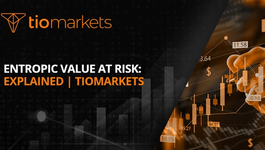Understanding Crypto Market Indicators: A Beginner’s Guide
BY TIOmarkets
|May 23, 2024Welcome to "Understanding Crypto Market Indicators: A Beginner’s Guide." In this article, we will introduce you to the exciting world of cryptocurrency and help you understand the importance of market indicators in this rapidly growing industry.
Introduction to Cryptocurrency
Cryptocurrency has taken the financial world by storm. But what exactly is cryptocurrency? Put simply, cryptocurrency is a digital or virtual form of currency that uses cryptography for secure financial transactions. Unlike traditional currencies issued by governments, cryptocurrencies operate independently of any central authority.
One of the key features of cryptocurrencies is their decentralized nature, meaning they are not controlled by any single entity like a government or financial institution. This decentralization is made possible by blockchain technology, which serves as a public ledger for all transactions. Each transaction is recorded on a block, which is then linked to the previous block, creating a chain of blocks - hence the name blockchain.
What is Cryptocurrency?
Cryptocurrency is built on a technology called blockchain, which is a distributed ledger that records all transactions across multiple computers. The most well-known cryptocurrency is Bitcoin, but there are now thousands of cryptocurrencies, each with its unique features and purposes.
Blockchain technology ensures the security and transparency of transactions in the cryptocurrency world. Every transaction is verified by network nodes through cryptography and recorded on the blockchain, making it nearly impossible to alter the transaction history. This level of security has made cryptocurrencies an attractive option for those seeking privacy and protection from fraud.
The Importance of Cryptocurrency in Today's Market
Cryptocurrencies have gained popularity due to their potential for high returns and the decentralization they offer. They have disrupted traditional financial systems and empowered individuals to take control of their finances.
Furthermore, the rise of cryptocurrencies has sparked innovation in various industries, leading to the development of new applications and technologies. Smart contracts, for example, are self-executing contracts with the terms of the agreement directly written into code. These contracts run on blockchain technology and automatically enforce and execute the terms of the agreement, eliminating the need for intermediaries and streamlining processes.
The Basics of Crypto Market Indicators
Before diving into the specifics of market indicators, it's essential to understand what they are and their role in cryptocurrency trading.
Market indicators are essential tools that provide valuable insights into the dynamics of the cryptocurrency market. These indicators serve as guideposts for traders, offering a glimpse into the complex world of digital asset trading. By utilizing market indicators, traders can gain a deeper understanding of market trends and potential price movements, enabling them to make more informed decisions.
Defining Market Indicators
Market indicators are tools used by traders to analyze market trends and predict future price movements. These indicators are usually derived from past and current market data, such as price, volume, and volatility. By studying these indicators, traders can make more informed decisions.
One of the key benefits of market indicators is their ability to provide traders with a systematic approach to analyzing market conditions. Through the use of technical analysis and statistical models, market indicators offer traders a structured framework for interpreting market data. This structured approach can help traders identify patterns, trends, and potential trading opportunities within the cryptocurrency market.
The Role of Market Indicators in Cryptocurrency Trading
Market indicators play a crucial role in cryptocurrency trading. They help identify potential buying and selling opportunities, determine market sentiment, and manage risk effectively. By combining market indicators with other analytical techniques, traders can increase their chances of success in this volatile market.
Furthermore, market indicators can also act as risk management tools for traders. By monitoring key indicators such as moving averages, relative strength index (RSI), and MACD (Moving Average Convergence Divergence), traders can assess market volatility and adjust their trading strategies accordingly. This proactive approach to risk management can help traders navigate the unpredictable nature of the cryptocurrency market with more confidence and precision.
Types of Crypto Market Indicators
There are various types of market indicators available to cryptocurrency traders. Let's explore some of the most common ones:
Volume-Based Indicators
Volume-based indicators measure the activity or liquidity within the market. They help traders understand the strength and significance of price movements. Some popular volume-based indicators include volume bars, on-balance volume (OBV), and accumulation/distribution (A/D) line.
Volume bars visually represent the amount of trading activity for a specific time period, giving traders insights into the intensity of buying and selling pressure. On-balance volume (OBV) is a cumulative indicator that adds or subtracts volume based on price movements, helping traders identify divergences between volume and price trends. The accumulation/distribution (A/D) line evaluates the flow of money into or out of a cryptocurrency, indicating whether a price movement is supported by strong buying or selling pressure.
Momentum Indicators
Momentum indicators assess the speed and strength of price movements. These indicators are particularly useful for identifying trend reversals and potential entry or exit points. Examples of momentum indicators include the relative strength index (RSI), stochastic oscillator, and moving average convergence divergence (MACD).
The relative strength index (RSI) measures the speed and change of price movements, indicating whether a cryptocurrency is overbought or oversold. The stochastic oscillator compares a cryptocurrency's closing price to its price range over a specific period, highlighting potential trend shifts. The moving average convergence divergence (MACD) combines short-term and long-term moving averages to signal changes in momentum, providing traders with insights into potential buying or selling opportunities.
Volatility Indicators
Volatility indicators measure the degree of price fluctuations in a given market. They help traders determine the potential risk and profit potential of a particular cryptocurrency. Popular volatility indicators include Bollinger Bands, average true range (ATR), and volatility stop.
Bollinger Bands consist of a moving average and two standard deviation lines, showing the volatility and potential price reversal points. Average true range (ATR) calculates the average price range of a cryptocurrency over a specific period, indicating the level of market volatility. Volatility stop is a dynamic indicator that adjusts stop-loss levels based on market volatility, helping traders manage risk effectively in fluctuating market conditions.
How to Read Crypto Market Indicators
Once you understand the different types of market indicators, it's important to know how to read them accurately to make informed trading decisions.
Understanding Indicator Charts
Most market indicators are depicted as charts or graphs. Learning to interpret these charts is crucial for understanding the overall market sentiment and identifying potential trends or patterns. Familiarize yourself with the various chart types, such as line charts, bar charts, and candlestick charts.
Interpreting Indicator Signals
Market indicators generate signals that can indicate potential buy or sell opportunities. These signals can be bullish or bearish, depending on the indicator and the market conditions. It's essential to understand how to interpret these signals in conjunction with other market factors to make effective trading decisions.
Strategies for Using Market Indicators
Now that you know the basics of market indicators and how to read them, let's explore some strategies for using them effectively in your cryptocurrency trading journey.
Timing Trades with Indicators
One way to utilize market indicators is by timing your trades based on the signals they generate. For example, if a momentum indicator indicates a strong uptrend, it might be a good time to consider entering a long position, or if a volatility indicator signals high volatility, it might be wise to adjust your risk management accordingly.
Risk Management Using Indicators
Market indicators can also be valuable tools for managing risk in cryptocurrency trading. By incorporating indicators that monitor price volatility or market sentiment, you can set stop-loss orders and take-profit levels more effectively. These risk management techniques can help protect your investment and optimize your overall trading strategy.
In conclusion, understanding crypto market indicators is vital for any beginner looking to navigate the world of cryptocurrency trading successfully. By learning about the different types of indicators, how to read them, and strategies for using them, you can make more informed trading decisions and increase your chances of success. Remember, the crypto market is volatile, so always practice sound risk management and never invest more than you can afford to lose. Happy trading!
Start Your Trading Journey with TIOmarkets
Ready to apply your newfound knowledge of crypto market indicators in live trading? Join TIOmarkets, the top-rated forex broker with over 170,000 accounts opened across more than 170 countries. With our platform, you can trade over 300 instruments across 5 markets, including Forex, indices, stocks, commodities, and futures, all with low fees. Plus, enhance your trading skills with our comprehensive educational resources and step-by-step guides. Take the first step towards successful trading by creating your trading account with TIOmarkets today. Create a Trading Account and embark on your journey to mastering the markets.

Risk disclaimer: CFDs are complex instruments and come with a high risk of losing money rapidly due to leverage. You should consider whether you understand how CFDs work and whether you can afford to take the high risk of losing your money. Never deposit more than you are prepared to lose. Professional client’s losses can exceed their deposit. Please see our risk warning policy and seek independent professional advice if you do not fully understand. This information is not directed or intended for distribution to or use by residents of certain countries/jurisdictions including, but not limited to, USA & OFAC. The Company holds the right to alter the aforementioned list of countries at its own discretion.
Join us on social media

Behind every blog post lies the combined experience of the people working at TIOmarkets. We are a team of dedicated industry professionals and financial markets enthusiasts committed to providing you with trading education and financial markets commentary. Our goal is to help empower you with the knowledge you need to trade in the markets effectively.
Related Posts





